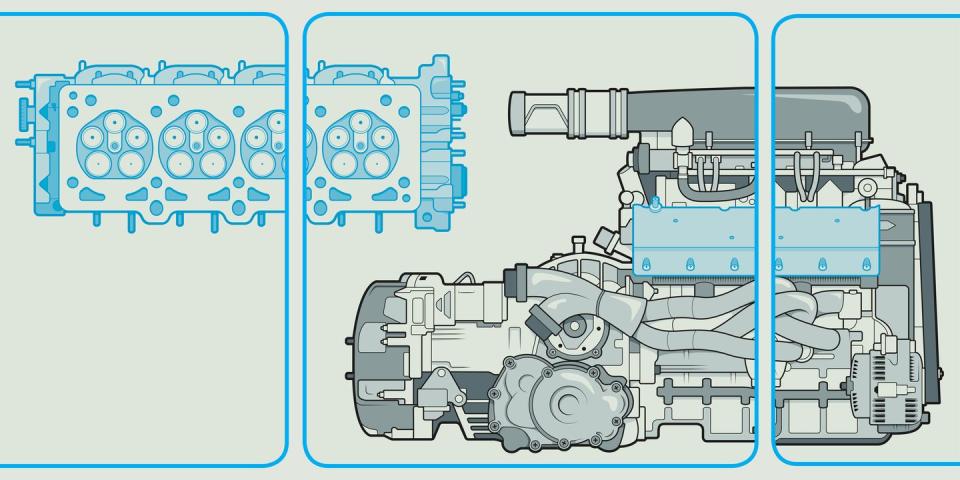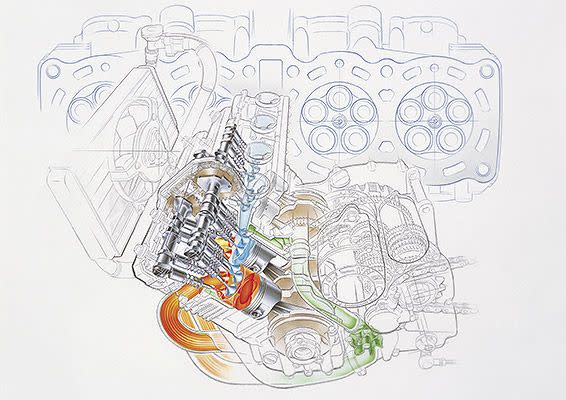What Ever Happened to Five-Valve Cylinder Heads?

Ferrari was so proud of its five-valve cylinder heads, it changed a naming convention that ran back over 25 years. For its previous mid-engine two-seaters, the three-digit name was derived from displacement and cylinder count, but the F355 did not have a 3.5-liter five-cylinder. It had a 3.5-liter V-8 with five-valve heads.
The F50 came a year after the F355 and its V-12, derived from Ferrari's Formula 1 engine, also had five-valve heads accounting for a wonderful 60 valves in total. The F355's successor, the 360, used the 40-valve V-8, with a small bump in displacement, but that was the last time Ferrari ever used the technology. It wasn't just Ferrari either. Yamaha pioneered five-valve internal-combustion with bikes in the Eighties, Mitsubishi was the first to put the tech in a production car, the Volkswagen Group had a number of five-valve production-car engines, and even conservative Toyota experimented with the technology. By 2010, it was all gone. No one was doing five-valve heads.
To explain why, we have to get back to basics. Remember that an internal-combustion is, at the end of the day, an air pump. An extremely complex air pump, but an air pump all the same. To get more out of it, you need to get more air in and more air out. "There's basically three ways to make power in an engine," says Steve Dinan, the legendary BMW tuner and engine builder, in an interview with Road & Track, "either make the engine bigger, turn more rpm or increase the cylinder pressure."
The idea behind a five-valve head was to both increase cylinder pressure and revs, making it a good idea in situations where displacement was fixed. A cylinder head with three intake and two exhaust valves could bring benefits in volumetric efficiency—how much air and fuel an engine takes in on an intake stroke—compared with a traditional four-valve head. Despite requiring smaller valves, the total circumference of the three intake valves in a five-valve head can be greater than two larger intake valves in a four-valve head. Dinan explains the theory at the time was that you could increase the intake-valve area to around 45 percent of an engine's bore with a third intake valve, compared with around 40 percent with two larger valves. Each of the valves is lighter, too, enabling higher engine speeds without valve float.

Yamaha debuted the world's first production five-valve internal-combustion engine in 1984 with the FZ750, and touted at the time that its five-heads offered 10 percent more power and five percent greater fuel efficiency than a four-valve head. The FZ750 made around 100 hp and revved to 11,800 rpm. Ferrari's first five-valve V-12 arrived in Formula 1 in 1989 and it powered cars that allowed the Scuderia to take the fight to McLaren and Williams. (Yamaha also introduced a five-valve engine in F1 in 1989, though not to notable success. The Japanese company also made five-valve Formula 2 and Formula 3000 engines.) The F355's V-8 broke new ground for automotive internal-combustion engines, with a specific output of 109 hp/liter—then a record for naturally aspirated road cars—and an 8500-rpm rev limit. Ferrari actually told R&T back in 1994 that the valvetrain was safe to 10,000 rpm.
Ultimately, however, the gains made by adding a third intake valve are small. "The problem is that because the valve stem and guide are in the way, it disrupts flow," Dinan explains. "Then you have seats between the three intake valves, and you have port geometry to feed three valves instead of two. You wind up not actually flowing any more air than a four-valve motor. I mean maybe two or three percent. It's really small, and that can easily be negated if you just make the bore two millimeters bigger and the stroke two millimeters shorter. You wind up with the same displacement and the same valve area as three intake valves."
Five-valve heads are also more complex. An automaker needs to manufacture and install more components—more valves, springs, guides, rocker arms, camshaft lobes—and little things like this add up in the world of mass production. Consider, too, that extra components mean more maintenance. Ultimately, whatever small gains in horsepower a third intake valve might bring aren't worth the extra cost and complexity, especially when an engine designer can make tiny changes to the bore and stroke of the engine.


 Yahoo Autos
Yahoo Autos 